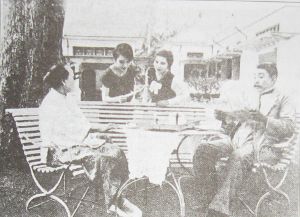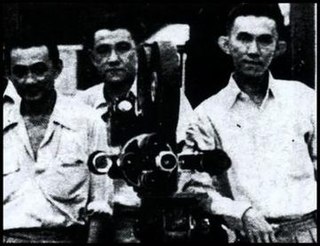Related Research Articles

Eulis Atjih is a 1927 film from the Dutch East Indies ; it was the second feature film produced in the country, after Loetoeng Kasaroeng in 1926. The silent film follows the lives of a native Indonesian family sent into poverty by the husband's splurging. Eulis Atjih was a commercial success in the Indies, but failed in international markets.

Pareh, released internationally as Pareh, Song of the Rice, is a 1936 film from the Dutch East Indies. Directed by the Dutchmen Albert Balink and Mannus Franken, it featured an amateur native cast and starred Raden Mochtar and Soekarsih. The story follows the forbidden love between a fisherman and a farmer's daughter.

The Teng Chun, also known by his Indonesian name Tahjar Ederis, was an Indonesian film producer. Born to a rich businessman, The became interested in film while still a youth. After a period as an exporter, in 1930 he established Cino Motion Picture to produce films in the Dutch East Indies. In a little over a decade he and his company had released at least 31 films, including some of the country's first talkies. Although he experienced a brief resurgence during the 1950s, after Indonesia became independent, he spent the last years of his life as an English teacher.

George Eduard Albert Krugers was a cameraman and film director active in the Dutch East Indies during the early 20th century. He is recorded as having worked in film since the mid-1920s, and in 1927 he made his directorial debut, Eulis Atjih. He joined hajj pilgrims in 1928 and screened the resulting documentary in the Netherlands. His 1930 film Karnadi Anemer Bangkong is thought to be the first talkie in the cinema of the Indies, but was a commercial failure as the majority Sundanese audience considered it insulting. After making two works for Tan's Film in the early 1930s, Krugers moved to Hong Kong and then the Netherlands.

Lilly van Java, also known as Melatie van Java, is a 1928 film from the Dutch East Indies directed by Nelson Wong. Initially meant to be produced by South Sea Film and shot by an American director, the film – which follows a woman told to marry a man she does not love – was ultimately completed by Wong's Halimoen Film. Details on its cast and performance are contradictory, although the film is recognised as the first of a long series of ethnic Chinese-produced films in the country. It is likely a lost film.

Loetoeng Kasaroeng is a 1926 fantasy film from the Dutch East Indies which was directed and produced by L. Heuveldorp. An adaptation of the Sundanese folktale Lutung Kasarung, the film tells of a young girl who falls in love with a magical lutung and stars the children of noblemen. Details on its performance are unavailable, although it is known to have been of poor technical quality and thought to have performed poorly. It was the first film produced in the country and the first to feature a native-Indonesian cast. It is likely a lost film.

The Wong brothers were three ethnic Chinese film directors and cameramen active in the cinema of the Dutch East Indies. The sons of an Adventist preacher, the brothers – Nelson (1895–1945), Joshua (1906–1981), and Othniel (1908–1986) – received much of their education in the United States before going to Shanghai and establishing The Great Wall Productions.

Roekihati is a 1940 film from the Dutch East Indies. Directed by the brothers Joshua and Othniel Wong and produced by Tan's Film, it follows a young village woman who goes to the city and encounters various difficulties. Targeted at lower-class audiences, it was shot in black-and-white and starred Roekiah and Raden Djoemala.
Boenga Roos dari Tjikembang is a 1931 film from the Dutch East Indies directed, produced, and filmed by The Teng Chun. Based on a 1927 novel of the same name, it follows the complicated romantic situations of two generations of ethnic Chinese in the Indies. An early example of domestic sound films, the film was remade in 1975.

Siti Akbari is a 1940 film from the Dutch East Indies directed by Joshua and Othniel Wong and produced by Tan Khoen Yauw. Starring Roekiah and Rd Mochtar, it follows a couple while the husband commits adultery.

Indonesia Malaise is a 1931 film directed by the Wong brothers. It was the brothers' first sound film and one of the first such films in the Dutch East Indies. Billed as a comedy, the story follows a woman who is overcome by tragedy in her personal life. A commercial failure, it may be lost.
Sam Pek Eng Tay is a 1931 film directed and produced by The Teng Chun and released in the Dutch East Indies. It is based on the Chinese legend The Butterfly Lovers, which follows the doomed love between a rich girl and a commoner boy. The film was a commercial success, inspiring The Teng Chun to direct several further films based on Chinese mythology. The name derives from the given names of the legend's two main characters, Liang Shanbo (梁山伯) and Zhu Yingtai (祝英台).

Huwen op Bevel is a 1931 romance film from the Dutch East Indies. Directed by George Krugers and thought to have been produced by Tan's Film, it follows two young lovers who are nearly separated but can ultimately be together. A critical flop, it was Krugers's last as a director. It is likely lost.
Elang Darat is a 1941 film from the Dutch East Indies which was directed by Inoe Perbatasari and produced by The Teng Chun for Jacatra Film. A detective film, it follows a man who comes to a village to track the villainous bandit known only as "Elang Darat".
Njai Dasima is a 1932 film from the Dutch East Indies which was directed by Bachtiar Effendi for Tan's Film. It was the second film adapted from G. Francis' 1896 novel Tjerita Njai Dasima, following a silent version in 1929. Starring Momo and Oesman, it followed a young Sundanese njai (concubine) who is tricked into marrying a man who does not love her and ultimately killed for her money. The film, the first talkie produced by its company, was also the first directed by a native Indonesian. The now-lost work received mixed critical reception.

Elly Joenara was an Indonesian film actress who later became a producer. She was the wife of producer Djamaluddin Malik.

Air Mata Mengalir di Tjitarum is a 1948 film from what is now Indonesia, written and directed by Roestam Sutan Palindih for the Tan & Wong Bros Film Company.

Akhmad Bassah, best known by the pen name Joehana, was an author from the Dutch East Indies who wrote in Sundanese. He worked for a time on the railroad before becoming an author by 1923, and had a strong interest in social welfare; this interest influenced his novels. He was also a productive translator, dramatist, and reporter, and operated a company which offered writing services. Sources disagree when Joehana died; some offer 1930, while others give 1942–45.

Star Film was a film production company in the Dutch East Indies. Established by Chinese-Indonesian businessman Jo Eng Sek and Chinese cameraman Cho' Chin Hsin in 1940, it produced five black-and-white films in 1940 and 1941; two of these were directed by Jo, and the remainder were directed by Wu Tsun. Another film was under production when the studio was closed following the Japanese occupation of the Dutch East Indies. Star helped establish the careers of actors such as S Waldy and Elly Joenara, and produced screenplays written by Rd Ariffien and Saeroen; its output, however, is probably lost.
References
Footnotes
- ↑ Said 1982, p. 141.
- 1 2 Kartiwan et al. 2010, p. 6.
- ↑ Biran 2009, pp. 60–61.
- ↑ Biran 2009, p. 76.
- ↑ Filmindonesia.or.id, G. Krugers.
- ↑ Biran 2009, pp. 131–132.
- 1 2 Biran 2009, p. 137.
- 1 2 Filmindonesia.or.id, Karnadi.
- ↑ Biran 2009, pp. 98, 143.
- ↑ Heider 1991, p. 14.
- ↑ Biran 2009, p. 351.
- ↑ Susanto 2003, p. 241.
- ↑ Biran 2009, p. 136.
Bibliography
- Biran, Misbach Yusa (2009). Sejarah Film 1900–1950: Bikin Film di Jawa [History of Film 1900–1950: Making Films in Java] (in Indonesian). Jakarta: Komunitas Bamboo working with the Jakarta Art Council. ISBN 978-979-3731-58-2.
- "G. Krugers". filmindonesia.or.id (in Indonesian). Jakarta: Konfidan Foundation. Archived from the original on 17 April 2014. Retrieved 17 August 2012.
- Heider, Karl G (1991). Indonesian Cinema: National Culture on Screen . Honolulu: University of Hawaii Press. ISBN 978-0-8248-1367-3.
- "Karnadi Anemer Bangkong". filmindonesia.or.id. Jakarta: Konfidan Foundation. Archived from the original on 2 December 2013. Retrieved 11 September 2012.
- Kartiwan, Irwan; Katuuk, Kamadjaya Al; Soenardji, Hendra N; Dahlan, Sandra Dewi (2010). Wajah Jasa Konstruksi Indonesia: Tinjauan Keberpihakan [The Face of Indonesia's Construction Services: An Examination of Rights] (in Indonesian). Jakarta: Gramedia. ISBN 978-979-22-6216-2.
- Said, Salim (1982). Profil Dunia Film Indonesia[Profile of Indonesian Cinema] (in Indonesian). Jakarta: Grafiti Pers. OCLC 9507803.
- Suryadinata, Leo (1995). Prominent Indonesian Chinese: Biographical Sketches. Singapore: Institute of Southeast Asian Studies. ISBN 978-981-3055-03-2.
- Susanto, A. Budi (2003). Identitas Dan Postkolonialitas Di Indonesia [Identity and Postcolonialism in Indonesia]. Yogyakarta: Kanisius. ISBN 978-979-21-0851-4.